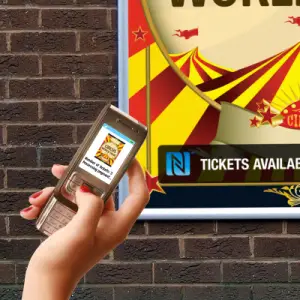Spacing published an article the other day about a new way for users to interact with subway advertising devised by a few students at the Miami Ad School. The idea they propose is called the  Underground Library and the gist of it is that ads would be placed in the trains of the New York subway system which would have a Near Field Communication (NFC) chip embedded in them which would allow people with NFC enabled smartphones (not iPhones…sorry) to touch their phone to the active portion of the poster and download a ten page sample of the book that is designated on the poster. Theoretically a single poster could even offer multiple books. You can read the sample and it will let you know of nearby library branches which have the book available to borrow.
Underground Library and the gist of it is that ads would be placed in the trains of the New York subway system which would have a Near Field Communication (NFC) chip embedded in them which would allow people with NFC enabled smartphones (not iPhones…sorry) to touch their phone to the active portion of the poster and download a ten page sample of the book that is designated on the poster. Theoretically a single poster could even offer multiple books. You can read the sample and it will let you know of nearby library branches which have the book available to borrow.
I’ve already seen a similar idea put to use. A few months ago in the PATH system in downtown Toronto there were ads for the Samsung S3 (I think) that used NFC technology to allow people who own that phone to put their phone up to the billboard and download a song to their phone. There were two versions of the ad, one with a male figure holding the phone and one with a female. When I saw the ad all I could think was the massive bounty of information that the advertiser must have been getting. They would have learned the minimum number of S3 users who were in the area on a daily basis, the number who chose the male versus the female option, and who knows what other identifying data the phone may have provided during the download (this is all assuming there was any way to record the data in the poster…I’m just hypothesising here). If that information were recorded, it would be a marketer’s dream.
I’m surprised that I haven’t yet seen any of the big publishers or bookstores doing this. What’s to stop publishers from using a similar system to provide free previews of their upcoming books, or bookstores from buying ad space to advertise best-sellers and link directly to their website to allow people to purchase their books on the go? Kindle users can already download previews of eBooks from Amazon and then choose to buy the full book from within the preview. Some authors, like Cory Doctorow or Spider Robinson, mention bookstores on their websites that carry their books. As the article in Spacing mentions, the sample you download could notify you of nearby library branches that have the book; if the poster is a publisher’s ad, why could it not instead list nearby stores that carry the book? Or if it is an ad from a specific bookstore, list the nearest location to the subway station the ad is in?
An NFC-enabled poster creates a link between the virtual world and the real world. It allows eBooks to gain a physical presence through which they are distributed even allowing eBooks to be distributed in an area such as the subway that has no cell phone reception or wi-fi signal. It can be used to market the eBooks themselves or the print editions of the book, or both.
